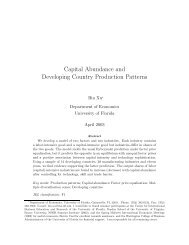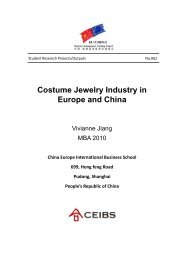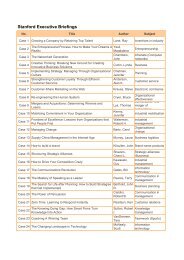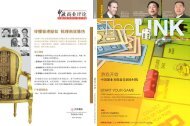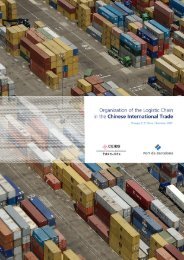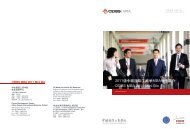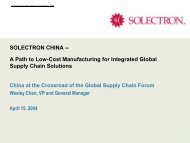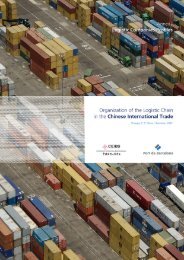PERSPECTIVES ON THE EVOLUTION OF THE AUTOMOBILE ...
PERSPECTIVES ON THE EVOLUTION OF THE AUTOMOBILE ...
PERSPECTIVES ON THE EVOLUTION OF THE AUTOMOBILE ...
You also want an ePaper? Increase the reach of your titles
YUMPU automatically turns print PDFs into web optimized ePapers that Google loves.
Automotive Industry in China<br />
most of their revenues come from JV sales. However, on the other hand, once they<br />
are able to produce their own cars with a similar quality of those produced by the JVs,<br />
they believe that Chinese consumers will prefer to buy Chinese brands.<br />
JVs seem to be focused in the China market and we have not found any trace or<br />
tendency of change. JVs state to have no plans and no interest in exporting massively<br />
China made cars. However, we have seen Honda is already exporting cars and some<br />
other JVs are setting plants only for export.<br />
Nevertheless, we should not forget that they are still in the battle to win market share<br />
in China. Although the JV’s have a big market share compared to the local companies,<br />
the market is still very fragmented and the each time better performing Chinese car<br />
brands are a real threat.<br />
Furthermore, there are some things that the JV’s should take into account:<br />
The risk of losing their know-how seems to be much higher than the potential<br />
cost savings.<br />
It seems quite sure that China made cars will not have the quality of the<br />
European or U.S. made cars yet. This is because of the supplier’s standards<br />
and raw materials quality.<br />
The governmental pressures in Europe or U.S. to protect the automotive<br />
industry are not negligible.<br />
For big quantity exports the cost advantage of China is not enough to<br />
counteract the transportation and logistic expenses. Exporting from China<br />
only makes sense for small quantities. For big quantities it makes more sense<br />
to localize the production.<br />
c) New Players<br />
Some of the New Players can leverage on the financial support of the government to<br />
acquire or merge with other companies. We should not forget that mergers have many<br />
risks, and that the resulting company may not be able to take advantage of the<br />
potential synergies. Consequently, in one hand these companies could become bigger<br />
and stronger but they could also lose competitiveness and fail in the process of<br />
integration after the mergers. Bigger companies could have more necessity in<br />
exporting. They could use the overcapacity built in China in recent years before the<br />
actual recession, to sell abroad. However, their export sales will clearly depend on the<br />
protectionist tendencies worldwide.<br />
In fact some of the New Players are announcing on the press their interest in<br />
conquering Europe and the U.S. market. The companies that seem more likely to<br />
reach this goal in a short term are Geely, Chery, BYD and Great Wall motors.<br />
Geely planned to sell cars in Europe in 2007 but it did not manage to reach the market<br />
standards. Nowadays Geely is exporting to Russia, Ukraine and the Middle East. It<br />
plans to sell in Europe starting from countries that have no major car industry of their<br />
own like the Netherlands or Austria. Later it plans to export to developed markets<br />
Port of Barcelona Chair of Logistics 44



